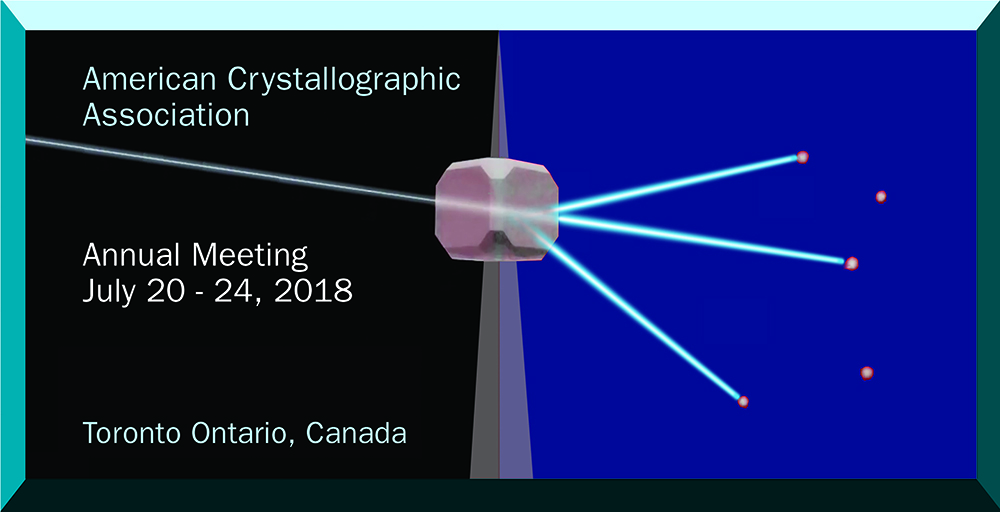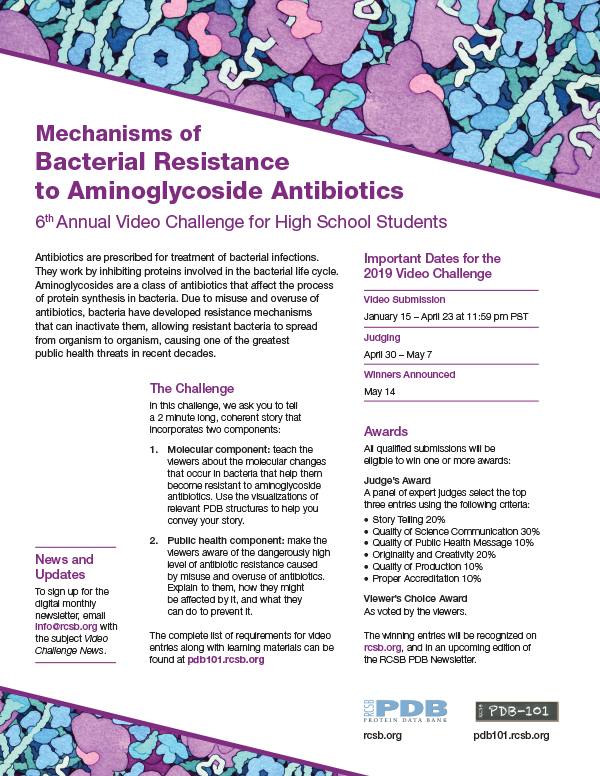Outreach and Education 
Annual Report Published

Download the 2017 Annual Report (PDF) for an overview of data deposition, query, outreach, and education activities.
This review highlights many RCSB PDB accomplishments, including a look at the global impact of the resource.
These bulletins provide a yearly snapshot of RCSB PDB activities and the state of the PDB archive. This edition is available as a PDF. If you would like a printed copy, please send your postal address to info@rcsb.org.
Meet PDB in VR with Nanome

|

|
Explore PDB structures in virtual reality–for free. San Diego-based Nanome Inc., which created the first molecular modeling app for modern VR systems, has released its flagship software (Nanome) for free download on the Oculus, Steam, and Viveport stores. Nanome opens the door to a virtual world where users can experiment, design, and learn at the nanoscale alongside colleagues and friends.
Nanome imports molecular structures directly from resources such as RCSB PDB, PubChem and DrugBank. Users can measure distances and angles between atoms, mutate amino acids, design new molecules, and much more. Nanome promotes seamless collaboration on on research, classroom presentations, or homework. Critical research findings can be presented in a virtual world alongside colleagues, friends, and audiences around the world.
Nanome has worked with RCSB PDB to offer an ever-changing "Featured Molecules" menu that highlights structures featured in the Molecule of the Month series along with selected small molecules.

|

|
Meetings and Events
RCSB PDB enjoys meeting with PDB users at meetings and symposia. Recent highlights included:

Intelligent Systems for Molecular Biology
RCSB PDB team members visited Chicago in July for the 26th Conference on Intelligent Systems for Molecular Biology (ISMB). Of special interest was a session organized by Stephen Burley and Jose Duarte on Single-particle Cryo-electron Microscopy, Cryo-electron Tomography, and Integrative/Hybrid Methods Studies of Macromolecular Machines: Opportunities and Challenges for the Bioinformatics Community. Among the most exciting of newly-deposited PDB structures are those coming from single particle cryo-electron microscopy (EM) and cryo-electron tomography (ET). Recent technical advances in sample preparation, electron optics, direct electron detection, and data processing software have created a perfect storm for the PDB. With these new methods cryo-EM and -ET are producing atomic level structures of macromolecular machines, such as multi-subunit RNA and DNA polymerases, ribosomes, and nuclear pore complexes. The next wave of exciting new structures will come from so-called integrative/hybrid methods, which typically combine cryo-EM or -ET data with data from chemical cross-linking, fluorescence resonance energy transfer, and homology models to produce multi-scale structures of even larger biomolecular machines.
The Special Session highlighted examples of the exciting work going in these two frontier areas of structural biology with reference to the manifold challenges and opportunities for the bioinformatics community. Presenters will include Yuan He (Northwestern University), Wei Dai (Rutgers), Barak Raveh (UCSF), and Alexander Rose (UCSD).
Another session focused on activities in involved with the ELIXIR organization. ELIXIR unites Europe’s leading life science organizations in managing and safeguarding the increasing volume of data being generated by publicly funded research. As part of the presentations, Stephen Burley presented Worldwide Protein Data Bank: Shared management of a global biological data resource for the public good.
During the 3DSig poster session, team members presented
- Automated evaluation of quaternary structures from protein crystal structures (Jose Duarte)
- Mol*: Creating a common library for web molecular graphics and analysis tools (Alex Rose)
- RCSB PDB: Sustaining a living digital data resource that enables breakthroughs in scientific research and biomedical education (Stephen Burley)
The RCSB PDB Poster Prize was awarded to Fergus Boyles for Learning from the ligand: improving binding affinity prediction using molecular descriptors (Fergus Boyles, Charlotte Deane, Garrett Morris, University of Oxford, United Kingdom). Many thanks to Co-Chairs Casey Greene (University of Pennsylvania) and Arjun Krishnan (Michigan State University), and Steven Leard (ISMB).

American Crystallographic Association
The 2018 Meeting of the American Crystallographic Association (ACA) in Toronto, Canada was kicked off with a special workshop on Molecular Art & Animation in 3D. RCSB PDB’s Maria Voigt led several sessions on Best Practices In Visual Communication, Introduction To Molecular Maya And Autodesk Maya, and Animation With Autodesk Maya. Later, Director Stephen Burley discussed Ligand Validation for the Protein Data Bank as part of the Best practices for building, refining, and analyzing ligands in macromolecular structures session.
Posters presented included
- Volume-ensemble search models for molecular replacement (Dmytro Guzenko)
- New Online Curriculum: The PDB Pipeline & Data Archiving (Catherine Lawson)
- RCSB PDB: Enabling Breakthroughs in Biomedical Research and Structure-Guided Drug Discovery (Stephen Burley)
- RCSB PDB: Sustaining a Living Digital Data Resource That Enables Breakthroughs in Scientific Research and Biomedical Education (Christine Zardecki)
Other highlights included meeting with depositors in the exhibit hall and building 3D protein models with students visiting ACA for the International Space Station Session.
The RCSB PDB Poster Prize was awarded to Dean Lang for Structural basis of substrate specificity in three groups of of N-methyltransferases important to benzylisoquinoline alkaloid metabolism (D.E. Lang, J.M. Lancaster, M.A. Torres, J.S. Morris, V.A. Maksimovich, P.J. Facchini, K.K.S. Ng, Department of Biological Sciences, University of Calgary, Calgary, Alberta, Canada).
Many thanks to Poster Prize Chair Louise Dawe (Wilfrid Laurier University) and judges Jeffrey Lee (University of Toronto), Eric J. Montemayor (University of Wisconsin–Madison), Rachel A. Powers (Grand Valley State University), Catherine Lawson (Rutgers University), Matthew Clifton (Nurix, Inc.), Clara L. Kielkopf (Rochester University), Edwin Stevens (Western Kentucky University), Ana G. Gonzalez (Lund University), and Blaine Mooers (Oklahoma University).

|

|
| RCSB PDB Postdoc Dmytro Guzenko won the Journal on Structural Dynamics Poster Prize at the 2018 American Crystallographic Association meeting. |
Winner Dean Lang and coauthor (and former RCSB PDB Poster Prize awardee) MIguel Torres. |
2019 Video Challenge Announced: Mechanisms of bacterial resistance to aminoglycoside antibiotics

Teachers, students, and science coordinators: spread the world about the challenge by sharing this flyer with your school.
The exploration of the PDB-101 biennial Health Focus theme Antimicrobial Resistance will continue in 2019 with the newest edition of the video challenge. This time we ask the students to explore the molecular mechanisms of bacterial resistance to aminoglycoside antibiotics. The first aminoglycoside antibiotic, streptomycin, was discovered in 1940s and proved crucial in treatment of tuberculosis. Since then, many other aminoglycoside antibiotics were developed and are used for treating diseases such as bacterial meningitis, gonorrhea, serious skin and bone infections, and many more.
The misuse and overuse of these and many other antibiotics caused bacteria to become resistant, and according the World Health Organization, it is one of the biggest threats to global health, food security, and development today.
This year’s challenge will follow a new timeline to encourage participation across the nation. The submission will be open from January 15th until April 23, 2019.
Award winners will be announced at rcsb.org and pdb101.rcsb.org on May 14, 2019. Visit the video challenge section on PDB-101 to find out the complete details.
Sign up to receive monthly newsletter with notifications about new resources and reminders about approaching deadlines.
